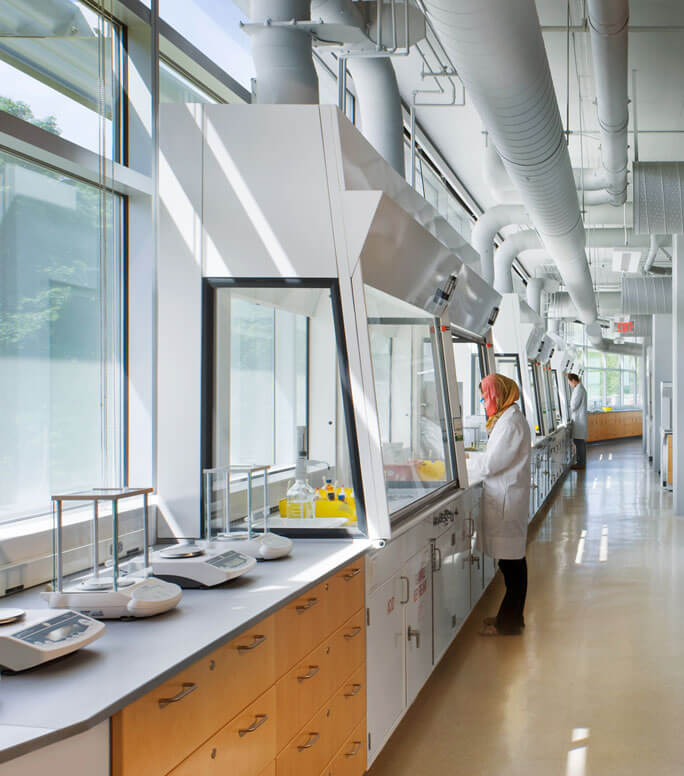If you had asked me a few years ago what came to mind when I thought about laboratories, I would have described a dingy room, deep inside a school building, with old benches, basic storage for glassware and possibly some hook-ups for gases and equipment. I pictured an uninspiring space that provided the practical, fundamental elements and technology for highly complicated scientific research to happen. I definitely would not have said it was the project type of my dreams upon leaving design school.
When I changed jobs recently, I found myself intrigued with being around architects and designers who believed these types of spaces deserved the same level of design as any of the more traditionally high design building types. With over a decade at a design firm that specialized in international corporate buildings, the shift to science and lab heavy buildings would challenge my experience and require a whole new set of knowledge. I was ready and excited to take this on and learn the complexities of these highly technical programs.

Then the pandemic hit, and new became even more new. I have always felt strongly that while online tools can be very helpful, the challenges encountered while designing and coordinating a building are best tackled in person. Nothing gets all the best ideas out there like a group of people standing around a table tossing around ideas. And even more importantly, the best way to learn new things is simply to be in the middle of it all.
Now we were in a situation where being in the middle of it all or sitting around a table were not options. I went from being surrounded by resources every day, to working remotely with only virtual communication. I was anxious that this reduction in face to face interaction would slow my ability to absorb the knowledge I needed in this new job. But now, a few months into my first lab project, and as happens with all unwanted change, I discovered some unexpected silver linings.
Working virtually has inevitably changed the way we communicate. Rather than having full access to ask all of my questions as I encounter things I have not done before, questions have to be prioritized and coordination happens in much less of a round table format. It has forced me to adjust the way I seek answers and encouraged me to problem solve by drawing on similarities from my previous experience. It has allowed me to look past the intimidation factor of such a highly technical program and trust my instincts in the broader design process.

A big part of design, and certainly the most visible, are the materials we choose for a space and how they are used and composed. These materials are what make a space feel classic or edgy, hard or soft, relaxing or energizing. They can make a space feel familiar or they can take on new, innovative forms and challenge our expectations. But what I believe is even more important for a well designed space is how it allows us to seamlessly do what we need to do within it – and if this aspect is done really well, we won’t even realize it.
A large portion of the design conversations for office spaces focus on providing a productive environment that includes all the amenities that make your workday enjoyable. It is not only about designing a space that looks cool, it is about providing privacy from distractions and meeting spaces for collaboration. In a restaurant the overall aesthetic can set the mood, but the experience is remembered by things like how efficiently the staff move around and provide service and whether the acoustics of the space allow a diner to hear the conversation at their table. In a hotel we all appreciate high end finishes, but ultimately we want easily navigable halls and a quiet room with a comfortable bed and an accessible plug for our phone.
The goals with designing laboratories are the same. As we design this lab, we have not talked at length about what the highly technical spaces with equipment will look like. Instead, we have been focused on ideas – for instance what will allow the users to move through their day without hassle and inspire them to develop innovative ideas. We are considering how to make the space enjoyable to be in throughout the day, and how to create an identity for the institution. It is about thinking beyond the obvious and creating a place that people are excited to be a part of.


